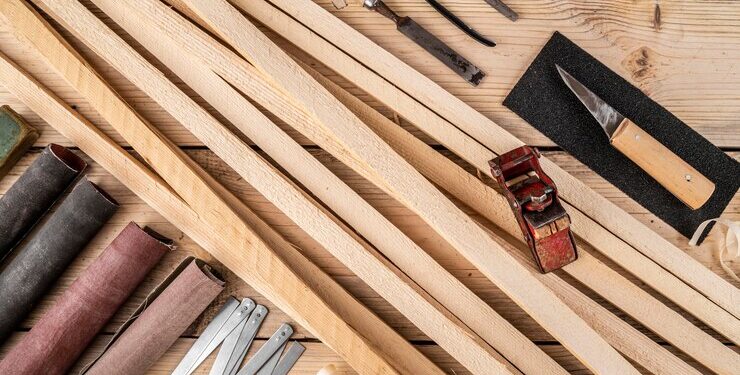When it comes to organizing and adding character to your home, shelving systems play a major role. The right wood components can elevate shelves from functional fixtures to eye-catching features that add warmth and style to any room. Whether you’re upgrading an existing shelving system or planning a new project, selecting the best wood elements can make a substantial difference. Let’s discuss the top wood components to consider for enhancing your home’s shelving systems and discover what makes each component stand out.
1. Wood Types and Finishes: Choosing the Foundation
First things first—what kind of wood should you use for your shelving? The wood type you choose impacts the look, durability, and overall vibe of your shelving system. Here are a few popular options:
- Oak: Known for its strength and beautiful grain patterns, oak is a popular choice for shelves that need to bear significant weight. Oak can be stained in various shades to complement a wide range of interior styles, from traditional to modern.
- Maple: Maple is another durable hardwood with a subtle grain, making it ideal for minimalist or contemporary spaces. It’s a bit lighter in color, which can help brighten up your shelving design.
- Walnut: Dark, rich, and luxurious, walnut wood adds a dramatic touch to shelves, creating an elegant, high-end look. It’s perfect if you want a striking contrast in rooms with lighter decor.
- Pine: A softer and more affordable wood, pine is excellent for those on a budget. Pine’s light color and natural knots work well in rustic or farmhouse-style homes.
When it comes to finishing, the options are endless. Natural oils bring out the grain patterns, while stains allow you to match your shelves with other furniture. You might even opt for painted finishes for a pop of color or a more uniform look. Choosing the right wood type and finish is the foundation of an attractive and functional shelving system.
2. Wood Brackets: Adding Both Style and Support
Shelving brackets are essential for stability, but they also serve as decorative elements. Wood brackets, in particular, add warmth and style to your shelves and can even become focal points of your design.
- Decorative Corbels: If you’re looking to add some charm, wooden corbels can be a great choice. These ornate brackets have an antique feel and are perfect for traditional or farmhouse-style shelves.
- Minimalist Brackets: Simple, streamlined wooden brackets can complement modern or minimalist decor. Their clean lines blend seamlessly into the shelf design, keeping the focus on the items you display.
- Floating Shelf Brackets: To achieve a floating shelf look, opt for concealed wood brackets. These hidden supports allow shelves to appear as if they’re attached to the wall without visible brackets, creating a sleek, modern appearance.
Not only do these brackets provide crucial support, but they also allow you to personalize the shelves to match your home’s decor style.
3. Edge Molding: Adding Elegance and Detail
Edge molding is a small but impactful detail that can enhance the look of your shelving system. Adding molding to the edges of your shelves can give them a finished, custom-built appearance and even change the overall feel of your space.
- Bullnose Molding: This rounded edge option is popular for creating a smooth, soft look. Bullnose edges work well in traditional or transitional homes, lending a touch of elegance to any room.
- Beveled Edges: A beveled edge provides a more angular, defined look, adding a slight architectural flair. It’s an excellent choice for contemporary spaces where you want clean lines with a bit of detail.
- Cove and Ogee Moldings: For a more decorative approach, cove or ogee moldings add intricate detail to your shelves, ideal for classic or Victorian-style homes. These edges create a sense of depth and can turn simple shelves into beautiful showpieces.
Adding molding is a straightforward way to elevate the look of your shelves, giving them a polished, finished quality that reflects your attention to detail.
4. Back Panels: Adding Color, Texture, and Stability
While back panels are optional, they’re an excellent addition to shelving systems. They provide extra support, prevent items from falling behind the shelves, and can also enhance the visual impact of your shelving.
- Plywood Backing: Plywood is a sturdy option that adds durability to your shelves. It can be stained or painted to match the rest of your shelving system or even covered with wallpaper for a unique look.
- Tongue-and-Groove Planking: This technique gives shelves a cozy, cottage-like feel. Tongue-and-groove planks add texture and dimension to your shelving, creating a visually appealing backdrop for the items on display.
- Beadboard Panels: For a vintage or farmhouse look, beadboard panels can add a charming touch to your shelves. The vertical grooves add subtle texture that works well in traditional or shabby-chic decor.
Back panels are a versatile way to enhance your shelving’s visual appeal while improving its stability. Plus, they give you the chance to add color or texture, complementing other elements in the room.
5. Wood Trim and Frames: Enhancing Structure and Style
Wood trim or framing around your shelves can make a major difference, giving them a built-in, cohesive look. Adding trim not only elevates the appearance of individual shelves but can also integrate the shelves seamlessly with the room.
- Framed Edges: Wood frames around the perimeter of each shelf provide a crisp, contained look. This framing technique is especially effective if you want your shelves to appear as part of the wall structure.
- Inset Shelving: Installing shelves into recessed wall spaces and framing them with wood trim creates a beautiful, built-in look. It’s a great option for smaller spaces or to turn alcoves into functional storage areas.
- Base and Crown Molding: If you’re aiming for a custom or luxury feel, adding base or crown molding to the top and bottom of your shelving system creates a dramatic effect. It’s ideal for large shelving units in living rooms or home libraries, where the extra details make a big impact.
Adding wood trim or frames is one of the best ways to make your shelving system look polished and professional, and it can be tailored to suit various design styles.
6. Accent Shelves: Mixing Function and Decor
Sometimes, the simplest way to enhance a shelving system is to incorporate a few accent shelves. Accent shelves break up the monotony and allow you to display unique pieces that add personality and warmth.
- Floating Accent Shelves: These standalone shelves can be added to a wall to complement larger shelving units. They’re perfect for displaying artwork, vases, or smaller decor items that you want to highlight.
- Live-Edge Wood Shelves: For a rustic or natural look, live-edge shelves, which retain the wood’s original shape and edge, add a sense of nature-inspired beauty to any space. They’re ideal as standalone shelves or in combination with other styles.
- Mixed Wood and Metal Shelves: Combining wood with metal brackets or frames creates an industrial feel, adding texture and contrast to the room. These shelves are both sturdy and visually interesting, perfect for modern and loft-style spaces.
Accent shelves offer a chance to showcase your style and experiment with different wood types and designs, creating a layered, dynamic shelving system that feels personalized.
7. Custom Wood Drawers: Adding Hidden Storage
Incorporating drawers into your shelving can offer a blend of open and closed storage options, making your shelves more functional. Wooden drawers allow you to store items out of sight while still maintaining a cohesive look.
- Built-In Wooden Drawers: Adding built-in drawers below your shelving creates a streamlined look, providing a place to store items that may not be display-worthy, such as electronics, cables, or paperwork.
- Sliding Barn Door Panels: For a more decorative twist, sliding barn-style doors made from wood can be installed over part of the shelving system. This technique allows for hidden storage without traditional drawer mechanisms, giving the shelves a unique, rustic feel.
- Pull-Out Trays: If full drawers aren’t feasible, pull-out wooden trays can add storage without compromising the open-shelf look. These trays can be hidden when not in use and easily accessed when needed.
Adding drawers or sliding panels helps keep your shelving system organized and versatile, making it easy to hide clutter without sacrificing style.
Final Thoughts: Designing a Shelving System that Complements Your Space
Enhancing your home’s shelving system with top-quality wood components is an investment in both style and functionality. By choosing the right wood type, incorporating attractive brackets and edge molding, and adding thoughtful details like back panels and accent shelves, you can create a shelving system that stands out. So, what’s your vision? Are you drawn to the sleek look of floating shelves, or do you envision rustic live-edge wood for a natural vibe? Let’s discuss how you can bring these elements together to design a shelving system that reflects your unique taste and enhances your home’s decor.


















